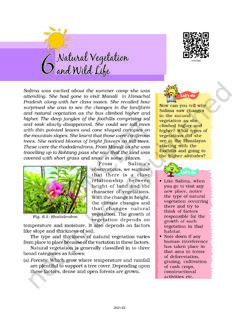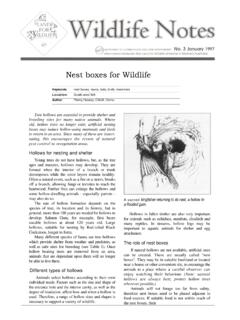Transcription of NATURAL VEGETATION AND WILDLIFE - Byju's
1 Have you observed the type of trees,bushes, grasses and birds in the fieldsand parks in and around your school?Are they similar or there are variations? Indiabeing a vast country you can imagine thetypes of bio-forms available throughout country India is one of the 12 megabio-diversity countries of the world. Withabout 47,000 plant species India occupiestenth place in the world and fourth in Asia inplant diversity. There are about 15,000flowering plants in India, which account for6 per cent in the world s total number offlowering plants. The country has many non-flowering plants, such as ferns, algae andfungi. India also has approximately 90,000species of animals, as well as, a rich variety offish in its fresh and marine VEGETATION refers to a plantcommunity, which has grown naturallywithout human aid and has been leftundisturbed by humans for a long time.
2 Thisis termed as a virgin VEGETATION . Thus,cultivated crops and fruits, orchards form partof VEGETATION but not NATURAL virgin VEGETATION , whichare purely Indian are known as endemic orindigenous species but those which have comefrom outside India are termed as exotic plants. The term flora is used to denote plants ofa particular region or period. Similarly, thespecies of animals are referred to as fauna. Thishuge diversity in flora and fauna kingdom isdue to the following VEGETATION AND WILDLIFERELIEFLandLand affects the NATURAL VEGETATION directlyand indirectly. Do you expect the same typeof VEGETATION in mountainous, plateau andplain areas or in dry and wet regions? Thenature of land influences the type ofvegetation.
3 The fertile level is generally devotedto agriculture. The undulating and roughterrains are areas where grassland andwoodlands develop and give shelter to avariety of soils also vary over space. Different typesof soils provide basis for different types ofvegetation. The sandy soils of the desertsupport cactus and thorny bushes, while wet,marshy, deltaic soils support mangroves anddeltaic VEGETATION . The hill slopes with somedepth of soil have conical character and extent of VEGETATION aremainly determined by temperature along withhumidity in the air, precipitation and soil. Onthe slopes of the Himalayas and the hills of thePeninsula above the height of 915 metres, thefall in the temperature affects the types ofvegetation and its growth, and changes it fromtropical to subtropical temperate and VEGETATION AND WILDLIFE43 Photoperiod (Sunlight )The variation in duration of sunlight at differentplaces is due to differences in latitude, altitude,season and duration of the day.
4 Due to longerduration of sunlight, trees grow faster : Environment Atlas of India, June 2001, Central Pollution Control Board, DelhiTable : Temperature Characteristics of the VEGETATION ZonesVegetation ZonesMean annualMean January(in degree C)(in degree C)TropicalAbove 24 CAbove 18 No FrostSubtropical17 C to 24 C10 C to 18 CFrost is rareTemperate7 C to 17 C-1 C to (-10) CFrost some snowAlpineBelow 7 CBelow 1 CSnowhumus to the soil and shelter to the s NATURAL VEGETATION has undergonemany changes due to several factors, such asthe growing demand for cultivated land,development of industries and mining,urbanisation and over-grazing of are the southern slopes in Himalayanregion covered with thick VEGETATION cover as comparedto northern slopes of the same hills?
5 PrecipitationIn India, almost the entire rainfall is brought inby the advancing southwest monsoon (June toSeptember) and retreating northeast of heavy rainfall have more dense vegetationas compared to areas of less are the western stopes of theWestern Ghats covered with thick forests and notthe eastern slopes?Have you ever thought as to why forestsare important for human beings? Forests arerenewable resources and play a major role inenhancing the quality of environment. Theymodify local climate, control soil erosion,regulate stream flow, support a variety ofindustries, provide livelihood for manycommunities and offer panoramic or scenicview for recreation. They control wind force andtemperature and cause rains.
6 They provideActivityCelebrate Van Mahotsav in your school/localityand plant a few spalings and notice their growthThe VEGETATION cover of India in large partsis no more NATURAL in the real sense. Except insome inaccessible regions, like the Himalayas,the hilly region of central India and themarusthali, the VEGETATION in most of the areashas been modified at some places, or replacedor degraded by human the bar graph (Figure ) andanswer the following questions.(i)Name the state having maximum area underforest cover.(ii)Name the union territory having minimumarea under forest cover and why?According to India State ofForest Report 2011, the forest cover in India per INDIA-ITYPES OF VEGETATIONThe following major types of VEGETATION maybe identified in our country (Figure ).
7 (i)Tropical Evergreen Forests(ii)Tropical Deciduous Forests(iii)Tropical Thorn Forests and Scrubs(iv)Montane Forests(v)Mangrove ForestsTropical Evergreen ForestsThese forests are restricted to heavy rainfallareas of the Western Ghats and the islandgroups of Lakshadweep, Andaman andNicobar, upper parts of Assam and Tamil Naducoast. They are at their best in areas havingmore than 200 cm of rainfall with a short dryseason. The trees reach great heights up to 60metres or even above. Since the region is warmand wet throughout the year, it has a luxuriantvegetation of all kinds trees, shrubs andcreepers giving it a multilayered structure. Thereis no definite time for trees to shed their such, these forests appear green all theyear Area under Forest CoverSource : India State of Forest Report 2013 14 AREA IN PER CENTSTATE/UTFigure : Tropical Evergreen Forest2019-20 NATURAL VEGETATION AND WILDLIFE45 Study the given map for the forest cover and try to find the reasons as to why certain states have more forest areaas compared to others?
8 Figure : NATURAL Vegetation2019-2046 CONTEMPORARY INDIA-IThe dry deciduous forests are found in areashaving rainfall between 100 cm and 70 forests are found in the rainier parts ofthe Peninsular plateau and the plains of Biharand Uttar Pradesh. There are open stretches,in which teak, sal, peepal and neem grow. Alarge part of this region has been cleared forcultivation and some parts are used for these forests, the common animals foundare lion, tiger, pig, deer and elephant. A hugevariety of birds, lizards, snakes and tortoisesare also found Thorn Forests and ScrubsIn regions with less than 70 cm of rainfall, thenatural VEGETATION consists of thorny trees andbushes. This type of VEGETATION is found in thenorth-western part of the country, includingsemi-arid areas of Gujarat, Rajasthan, MadhyaPradesh, Chhattisgarh, Uttar Pradesh andHaryana.
9 Acacias, palms, euphorbias and cactiare the main plant species. Trees are scatteredand have long roots penetrating deep into thesoil in order to get moisture. The stems aresucculent to conserve water. Leaves are mostlythick and small to minimise evaporation. Theseforests give way to thorn forests and scrubs inarid these forests, the common animals arerats, mice, rabbits, fox, wolf, tiger, lion, wildass, horses and : Thorn Forests and ScrubsSome of the commercially important treesof this forest are ebony, mahogany, rosewood,rubber and common animals found in these forestsare elephant, monkey, lemur and deer. One-horned rhinoceroses are found in the junglesof Assam and West Bengal. Besides theseanimals, plenty of birds, bats, sloth, scorpionsand snails are also found in these Deciduous ForestsThese are the most widespread forests of are also called the monsoon forests andspread over the region receiving rainfallbetween 200 cm and 70 cm.
10 Trees of this foresttype shed their leaves for about six to eightweeks in dry the basis of the availability of water,these forests are further divided into moist anddry deciduous. The former is found in areasreceiving rainfall between 200 and 100 forests exist, therefore, mostly in theeastern part of the country northeasternstates, along the foothills of the Himalayas,Jharkhand, West Odisha and Chhattisgarh,and on the eastern slopes of the Western is the most dominant species of this , sal, shisham, sandalwood, khair,kusum, arjun and mulberry are othercommercially important : Tropical Deciduous Forest2019-20 NATURAL VEGETATION AND WILDLIFE47 Figure : Mangrove ForestsMontane ForestsIn mountainous areas, the decrease intemperature with increasing altitude leads tothe corresponding change in naturalvegetation.












